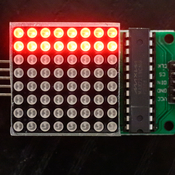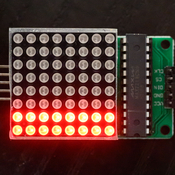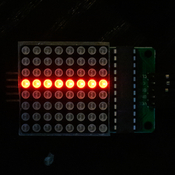Niglyn
Member
Hi,
Discussions in a few different treads about methods to measure shutter speed. The best solution is a proper tester (see my other thread 'Build a shutter tester for Focal Plane shutters - Cheap, Easy & it Works)
However, over the years all sorts of weird & wonderful ideas have cropped up.
Here is the implantation of one such idea., based on the use of a crt television & it's scanning rate. Rather than a large cumbersome crt, instead a cheap LED matrix is used.
Readme from the Github is below. All code & build docs can be found on Github.
It can be used for both digital & film camera!
Please post comments, thought & ideas hera and above all, if you build one, please post a photo & how you found it.
Happy to update, modify or add to the design should.
# Camera-Shutter-Tester-Optical-Cheap-Easy-It-Works
Whilst a proper shutter tester is the best and most accurate way to measure a camera shutter (see my other shutter tester)
Sometimes optical confirmation can be useful, or if using a digital camera, traditional film camera testers cannot be used.
This device is a very simple moving LED bar, which can be set to strobe at standard camera shutter speeds 1/32, 1/64, 1/128, 1/256 & 1/1024s by pushing the button.
(Note these are the genuine speeds, not the humanised 1/30, 1/125, 1/250...) speeds
Each row of LEDs is illumintaed to the set time (1/32s) for example, then extingished as the next row lights.
Setting the LEDs to strobe at the same as the camera shutter speed will result in two (sometimes one) line of LEDs being photograped (using a digital camera). If 3 or more rows are photographed, then it is an indication that the shutter speed is slow. (Set tke LEDs to 1/512 but the camera to 1/30, to see this effect)
For a film camera, remove the lens, open the back of the camera. When the shutter is operated you will see through the camera to the LED matrix. You will see the ame LED pattern as decribed above.
Only four parts are required,
Arduino Nano (or Uno) board,
LED matrix
Push-button (This is not even needed, you could just touch two wires together)
Two Dupont wires (or any bit of wire if you want to solder directly to the Arduino board)
Parts & links to them, as well as build docs & firmware are all in the files.

 github.com
github.com
Discussions in a few different treads about methods to measure shutter speed. The best solution is a proper tester (see my other thread 'Build a shutter tester for Focal Plane shutters - Cheap, Easy & it Works)
However, over the years all sorts of weird & wonderful ideas have cropped up.
Here is the implantation of one such idea., based on the use of a crt television & it's scanning rate. Rather than a large cumbersome crt, instead a cheap LED matrix is used.
Readme from the Github is below. All code & build docs can be found on Github.
It can be used for both digital & film camera!
Please post comments, thought & ideas hera and above all, if you build one, please post a photo & how you found it.
Happy to update, modify or add to the design should.
# Camera-Shutter-Tester-Optical-Cheap-Easy-It-Works
Whilst a proper shutter tester is the best and most accurate way to measure a camera shutter (see my other shutter tester)
Sometimes optical confirmation can be useful, or if using a digital camera, traditional film camera testers cannot be used.
This device is a very simple moving LED bar, which can be set to strobe at standard camera shutter speeds 1/32, 1/64, 1/128, 1/256 & 1/1024s by pushing the button.
(Note these are the genuine speeds, not the humanised 1/30, 1/125, 1/250...) speeds
Each row of LEDs is illumintaed to the set time (1/32s) for example, then extingished as the next row lights.
Setting the LEDs to strobe at the same as the camera shutter speed will result in two (sometimes one) line of LEDs being photograped (using a digital camera). If 3 or more rows are photographed, then it is an indication that the shutter speed is slow. (Set tke LEDs to 1/512 but the camera to 1/30, to see this effect)
For a film camera, remove the lens, open the back of the camera. When the shutter is operated you will see through the camera to the LED matrix. You will see the ame LED pattern as decribed above.
Only four parts are required,
Arduino Nano (or Uno) board,
LED matrix
Push-button (This is not even needed, you could just touch two wires together)
Two Dupont wires (or any bit of wire if you want to solder directly to the Arduino board)
Parts & links to them, as well as build docs & firmware are all in the files.
billbill100 - Overview
billbill100 has 9 repositories available. Follow their code on GitHub.



 )
) 












